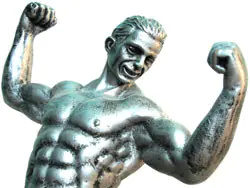Regular strength training exercises contribute to the formation of certain morphological as well as functional characteristics of the practitioner’s body. How does our body react to constant high-quality strength load? What changes occur in it? Well, let's take a closer look at the effect of physical exercise on the main systems of an athlete's body...
The musculoskeletal system undergoes maximum changes:
- I) the diameter of the diaphyses (ends) of tubular bones increases,
- II) the so-called compact layer of bone thickens, as well as the places where tendons attach to them (these changes are responsible for greater bone strength);
- III) skeletal muscles sharply hypertrophy (its mass increases),
- IV) muscle strength increases.
Strength training has a specific effect on blood circulation.
The heart increases in size, especially the left ventricle and left atrium - their cavities are stretched (dilated), and the muscle tissue (myocardium) is hypertrophied - this is how the heart adapts to difficult circulatory conditions with significant muscle tension under the influence of severe physical activity. For example, when lifting a barbell, just the minute volume of blood soars 1.5-2 times and actually reaches as much as 15-22 liters. Thus, the heart, adapted to significant physical activity, actually has an extremely high contractility. And this, as you understand, is the most important thing for a qualitative assessment of the health-improving effect of strength exercises.
Under the influence of increased muscle mass, the capillary network and blood volume also increase.
Performing various cyclic physical movements with weights forces the hematopoietic function to be stimulated: the number of red blood cells and the volume of hemoglobin increases, guaranteeing increased oxygen saturation of the blood. Also, as a result of increased physical activity, the main blood clotting systems are activated. In fact, this is one of the eloquent manifestations of the urgent adaptation (adaptation) of the body to the effects of force loads.
Systematic muscle activity mobilizes the body's main natural protective factors and its immunological stability through the formation of special protective blood complexes.
As a result of regular strength training, a high level of coordination of the respiratory system is formed:
Inhalation is performed in the negative phase (lowering the weight - the muscles lengthen), exhalation is performed in the positive phase (raising the weight - the muscles contract) of the strength exercise. High energy consumption during muscular work causes a greater need for oxygen, thus improving pulmonary ventilation: breathing becomes fuller and deeper, and therefore more economical.
When performing various strength exercises with maximum weight, trained athletes use straining (an attempt to exhale through a closed glottis), due to this the force of muscle contraction increases.
As you understand, such straining is not necessary for all representatives of various sports disciplines. For example, weightlifters and powerlifters can’t do without it, but, for example, track and field athletes or football players almost never use it.
Post Views: 72


